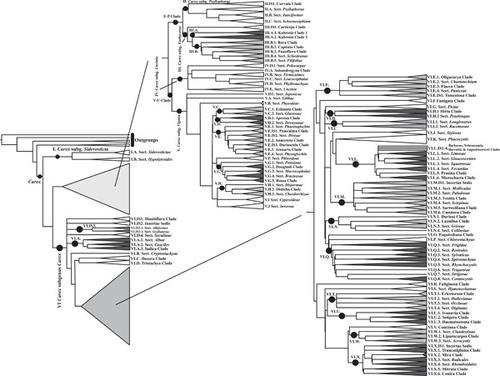当前位置:
X-MOL 学术
›
J. Syst. Evol.
›
论文详情
Our official English website, www.x-mol.net, welcomes your
feedback! (Note: you will need to create a separate account there.)
A framework infrageneric classification of Carex (Cyperaceae) and its organizing principles
Journal of Systematics and Evolution ( IF 3.4 ) Pub Date : 2020-12-28 , DOI: 10.1111/jse.12722 Eric H. Roalson 1 , Pedro Jiménez‐Mejías 2, 3 , Andrew L. Hipp 4 , Carmen Benítez‐Benítez 5 , Leo P. Bruederle 6 , Kyong‐Sook Chung 7 , Marcial Escudero 8 , Bruce A. Ford 9 , Kerry Ford 10 , Sebastian Gebauer 11 , Berit Gehrke 12 , Marlene Hahn 4 , Muhammad Qasim Hayat 13 , Mathias H. Hoffmann 11 , Xiao‐Feng Jin 14 , Sangtae Kim 15 , Isabel Larridon 16, 17 , Étienne Léveillé‐Bourret 18 , Yi‐Fei Lu 19 , Modesto Luceño 5 , Enrique Maguilla 8 , Jose Ignacio Márquez‐Corro 5 , Santiago Martín‐Bravo 5 , Tomomi Masaki 20 , Mónica Míguez 5 , Robert F. C. Naczi 21 , Anton A. Reznicek 22 , Daniel Spalink 23 , Julian R. Starr 24 , Uzma 13 , Tamara Villaverde 25 , Marcia J. Waterway 26 , Karen L. Wilson 27 , Shuren Zhang 28
Journal of Systematics and Evolution ( IF 3.4 ) Pub Date : 2020-12-28 , DOI: 10.1111/jse.12722 Eric H. Roalson 1 , Pedro Jiménez‐Mejías 2, 3 , Andrew L. Hipp 4 , Carmen Benítez‐Benítez 5 , Leo P. Bruederle 6 , Kyong‐Sook Chung 7 , Marcial Escudero 8 , Bruce A. Ford 9 , Kerry Ford 10 , Sebastian Gebauer 11 , Berit Gehrke 12 , Marlene Hahn 4 , Muhammad Qasim Hayat 13 , Mathias H. Hoffmann 11 , Xiao‐Feng Jin 14 , Sangtae Kim 15 , Isabel Larridon 16, 17 , Étienne Léveillé‐Bourret 18 , Yi‐Fei Lu 19 , Modesto Luceño 5 , Enrique Maguilla 8 , Jose Ignacio Márquez‐Corro 5 , Santiago Martín‐Bravo 5 , Tomomi Masaki 20 , Mónica Míguez 5 , Robert F. C. Naczi 21 , Anton A. Reznicek 22 , Daniel Spalink 23 , Julian R. Starr 24 , Uzma 13 , Tamara Villaverde 25 , Marcia J. Waterway 26 , Karen L. Wilson 27 , Shuren Zhang 28
Affiliation

|
Phylogenetic studies of Carex L. (Cyperaceae) have consistently demonstrated that most subgenera and sections are para- or polyphyletic. Yet, taxonomists continue to use subgenera and sections in Carex classification. Why? The Global Carex Group (GCG) here takes the position that the historical and continued use of subgenera and sections serves to (i) organize our understanding of lineages in Carex, (ii) create an identification mechanism to break the ~2000 species of Carex into manageable groups and stimulate its study, and (iii) provide a framework to recognize morphologically diagnosable lineages within Carex. Unfortunately, the current understanding of phylogenetic relationships in Carex is not yet sufficient for a global reclassification of the genus within a Linnean infrageneric (sectional) framework. Rather than leaving Carex classification in its current state, which is misleading and confusing, we here take the intermediate steps of implementing the recently revised subgeneric classification and using a combination of informally named clades and formally named sections to reflect the current state of our knowledge. This hybrid classification framework is presented in an order corresponding to a linear arrangement of the clades on a ladderized phylogeny, largely based on the recent phylogenies published by the GCG. It organizes Carex into six subgenera, which are, in turn, subdivided into 62 formally named Linnean sections plus 49 informal groups. This framework will serve as a roadmap for research on Carex phylogeny, enabling further development of a complete reclassification by presenting relevant morphological and geographical information on clades where possible and standardizing the use of formal sectional names.
中文翻译:

Carex (Cyperaceae) 的框架属下分类及其组织原则
Carex L.(莎草科)的系统发育研究一致表明,大多数亚属和部分是副系或多系的。然而,分类学家继续在Carex分类中使用亚属和部分。为什么?全球Carex小组 (GCG) 在这里采取的立场是,亚属和部分的历史和持续使用有助于 (i) 组织我们对Carex谱系的理解,(ii) 创建一种识别机制,将大约 2000 种Carex分为可管理的群体并刺激其研究,以及 (iii) 提供一个框架来识别Carex 中可通过形态学诊断的谱系. 不幸的是,目前对Carex中系统发育关系的理解还不足以在 Linnean 属下(部分)框架内对该属进行全球重新分类。与其将Carex分类留在其当前状态,这会产生误导和混淆,我们在这里采取中间步骤实施最近修订的亚属分类,并使用非正式命名的进化枝和正式命名的部分的组合来反映我们知识的当前状态。这种混合分类框架以对应于梯级系统发育上进化枝的线性排列的顺序呈现,主要基于 GCG 最近发布的系统发育。它组织Carex分为 6 个亚属,这些亚属又细分为 62 个正式命名的 Linnean 部分和 49 个非正式组。该框架将作为Carex系统发育研究的路线图,通过在可能的情况下提供有关进化枝的相关形态学和地理信息并标准化正式截面名称的使用,从而进一步发展完整的重新分类。
更新日期:2020-12-28
中文翻译:

Carex (Cyperaceae) 的框架属下分类及其组织原则
Carex L.(莎草科)的系统发育研究一致表明,大多数亚属和部分是副系或多系的。然而,分类学家继续在Carex分类中使用亚属和部分。为什么?全球Carex小组 (GCG) 在这里采取的立场是,亚属和部分的历史和持续使用有助于 (i) 组织我们对Carex谱系的理解,(ii) 创建一种识别机制,将大约 2000 种Carex分为可管理的群体并刺激其研究,以及 (iii) 提供一个框架来识别Carex 中可通过形态学诊断的谱系. 不幸的是,目前对Carex中系统发育关系的理解还不足以在 Linnean 属下(部分)框架内对该属进行全球重新分类。与其将Carex分类留在其当前状态,这会产生误导和混淆,我们在这里采取中间步骤实施最近修订的亚属分类,并使用非正式命名的进化枝和正式命名的部分的组合来反映我们知识的当前状态。这种混合分类框架以对应于梯级系统发育上进化枝的线性排列的顺序呈现,主要基于 GCG 最近发布的系统发育。它组织Carex分为 6 个亚属,这些亚属又细分为 62 个正式命名的 Linnean 部分和 49 个非正式组。该框架将作为Carex系统发育研究的路线图,通过在可能的情况下提供有关进化枝的相关形态学和地理信息并标准化正式截面名称的使用,从而进一步发展完整的重新分类。











































 京公网安备 11010802027423号
京公网安备 11010802027423号